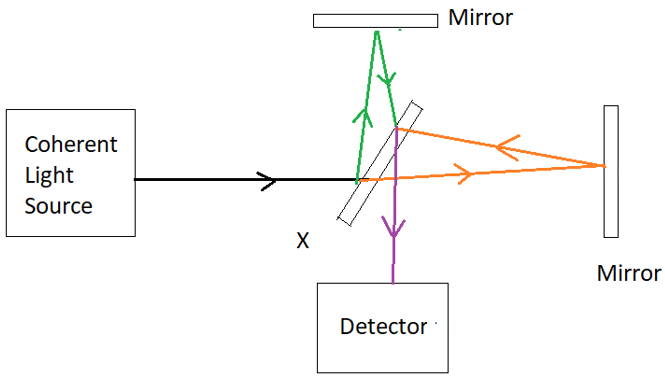This set of Engineering Physics Multiple Choice Questions & Answers (MCQs) focuses on “Michelson – Morley Experiment”.
1. Which of the following were one of the conclusions of the Michaelson Morley experiment?
a) All laws of physics remain invariant in all inertial frames
b) Light propagates with different speeds in different directions
c) Ether has no observable properties
d) The velocity of light in free space is constant
View Answer
Explanation: In Michaelson Morley experiment, the aim was to find the time difference from which the relative velocity between ether and the earth could be estimated. However, no shift was observed. Hence it proved, that ether has no observable properties and that velocity of light is same in all directions.
2. The result of the Michaelson Morley experiment was as expected.
a) True
b) False
View Answer
Explanation: When Michaelson Morley experiment was conducted, it was expected that light would propagate with different speeds in different directions as viewed from earth. But the result proved otherwise.
3. The device used in the Michaelson Morley experiment was ______
a) Telescope
b) Plain Grating
c) Interferometer
d) Prism
View Answer
Explanation: Interferometers are for measuring the interference properties of light waves. It gives very accurate and precise measurements. It is due to this purpose, that it was used in Michaelson Morley experiment, so as to be able to measure the fringe shift that occurs when light is propagated in different directions.
4. How much shift was expected in Michaelson-Morley experiment?
a) 0.01
b) 0.02
c) 0.03
d) 0.04
View Answer
Explanation: Michaelson designed a special device that would have accuracy far exceeding any other device. It was called Michaelson Interferometer. Using a light of wavelength 600 nm, a fringe shift of 0.04 was expected.
5. The fringes of equal inclination produced by using Michaelson Interferometer are called as ____
a) Equi-inclination Fringes
b) Michaelson’s Fringes
c) Haidinger’s Fringes
d) Morley’s Fringes
View Answer
Explanation: By using Michaelson Interferometer, fringes of equal inclination are obtained. These fringes are called as Haidinger’s fringes. All the fringes are concentric circles.
6. When the movable mirror of a Michaelson Interferometer is shifted through 0.0589 mm, 200 fringes cross the field. What is the wavelength of the light?
a) 5890 Å
b) 5245 Å
c) 4965 Å
d) 6894 Å
View Answer
Explanation: Here, d = 0.0589 X 10-3m, n = 200
Therefore, λ=\(\frac{2d}{n}\)
= 2 X 0.0589 X 10-3/200
= 5890 Å
7. When a thin plate of refractive index 1.5 is placed in the path of one of interfering beams of Michaelson Interferometer, a shift of 30 fringes is observed. If the thickness of plate is 0.018 mm, the wavelength of the used light is ____
a) 4000 Å
b) 5000 Å
c) 6000 Å
d) 7000 Å
View Answer
Explanation: Here, μ = 1.5, n = 30, t = 1.8 X 10-5m
Path difference due to the glass plate = 2(μ- 1) t
2(μ- 1) t = nλ
λ = 2(μ- 1) t/n
= 2 X 0.5 X 1.8 X 10-5/30
= 6000 Å.
8. In Michaelson interferometer, the position of mirror read 0.6025mm and 0.8970mm for a pair of consecutive bright. Mean wavelength of light is 5393 Å. The difference between the two wavelengths is ___
a) 3 Å
b) 4 Å
c) 5 Å
d) 6 Å
View Answer
Explanation: d = 0.8970 – 0.6025 = 0.2945 mm
= 2.945 X 10-4m
λ = 5893 X 10-10m
λ2–λ1 = \(\frac{\lambda^2}{2d} \)
= 5893 X 5893 X 10-20/2 X 2.945 X 10-4
= 6 Å.
9. When a plate of thickness 0.05 mm is placed in the path of a Michaelson Interferometer, a shift of 100 fringes is observed for a light of wavelength 5000 Å. What is the refractive index of the plate?
a) 1
b) 1.5
c) 2
d) 2.5
View Answer
Explanation: We know, μ = nλ/2t + 1
Here, λ = 5000 Å = 5 X 10-7 m, n = 100, t = 0.05 mm = 5 X 10-5m
Therefore, μ = 100 X 5 X 10-7/2 X 5 X 10-5 + 1
μ = 1.5.
10. Identify X.

a) Silvered Mirror
b) Thin sheet
c) Semi-silvered mirror
d) Fluorescent screen
View Answer
Explanation: X is semi-silvered mirror. It is used so that the incident light could be divided into two parts of equal intensity. One beam is reflected while one is transmitted across it. It is inclined at an angle of 45°.
Sanfoundry Global Education & Learning Series – Engineering Physics.
To practice all areas of Engineering Physics, here is complete set of 1000+ Multiple Choice Questions and Answers.
If you find a mistake in question / option / answer, kindly take a screenshot and email to [email protected]
